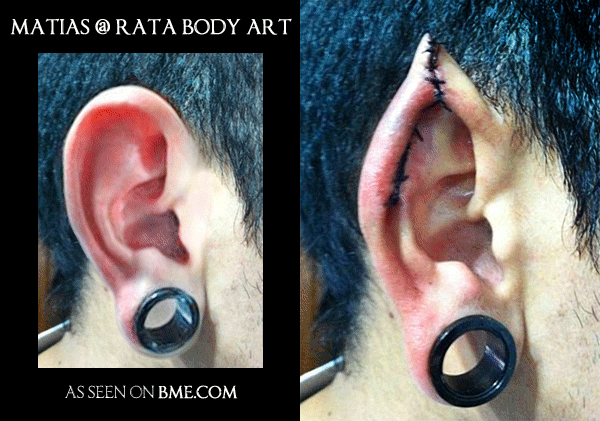To generalize, ear pointing works by cutting a piece out of the top of the ear, and then stitching the open portions together, folding the helix rim up into a point. It is a wonderful optical illusion that this makes it seem as if the ear has a point coming out the top, when in fact the ear has actually been lengthened very little, if at all, since we can only remove tissue — nothing is added. While additive procedures are theoretically possible, they appear currently beyond the reach of the body modification practitioner, if not beyond the reach of most reconstructive surgeons. In the majority of ear pointings done since Steve Haworth first invented them in the mid-1990s, the wedge-removal procedure has changed little — only the location, size, and shape differs (and varying the shape of the piece removed the result can cover a wide range of appearances).
However, Samppa Von Cyborg expanded the procedure by removing more than just what’s needed for the point, allowing one to reshape the entire contour of the ear. This related example is by Matias Tafel of Rata Body Art in Argentina. You can see from both the stitches and the animation that a long strip running much of the height of the ear has been excised, giving an end result where the ear is narrower as well as pointy. This narrowness brings with it the optical illusion of additional length/height, because it changes the length to height ratio and tricks the mind of the observer.

 BME/News and Modblog highlight only a small fraction of what
BME/News and Modblog highlight only a small fraction of what
Forgive me if this is a real “newbie” question – but does this affect hearing ability at all?
Forgive me if this is a real “newbie” question – but does this affect hearing ability at all?
Forgive me if this is a real “newbie” question – but does this affect hearing ability at all?
Forgive me if this is a real “newbie” question – but does this affect hearing ability at all?
This does not affect hearing. Please see http://www.youtube.com/watch?v=Wchhj4yt6_A&feature=g-all-u for a video with a client of mine that had this done. She and I answer some common questions. Please feel free to email me at [email protected]
Thank You
J
This does not affect hearing. Please see http://www.youtube.com/watch?v=Wchhj4yt6_A&feature=g-all-u for a video with a client of mine that had this done. She and I answer some common questions. Please feel free to email me at [email protected]
Thank You
J
This does not affect hearing. Please see http://www.youtube.com/watch?v=Wchhj4yt6_A&feature=g-all-u for a video with a client of mine that had this done. She and I answer some common questions. Please feel free to email me at [email protected]
Thank You
J
This does not affect hearing. Please see http://www.youtube.com/watch?v=Wchhj4yt6_A&feature=g-all-u for a video with a client of mine that had this done. She and I answer some common questions. Please feel free to email me at [email protected]
Thank You
J